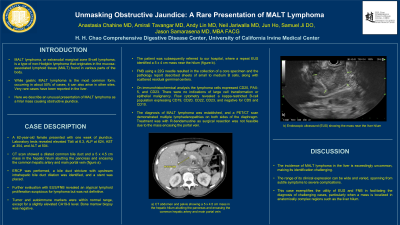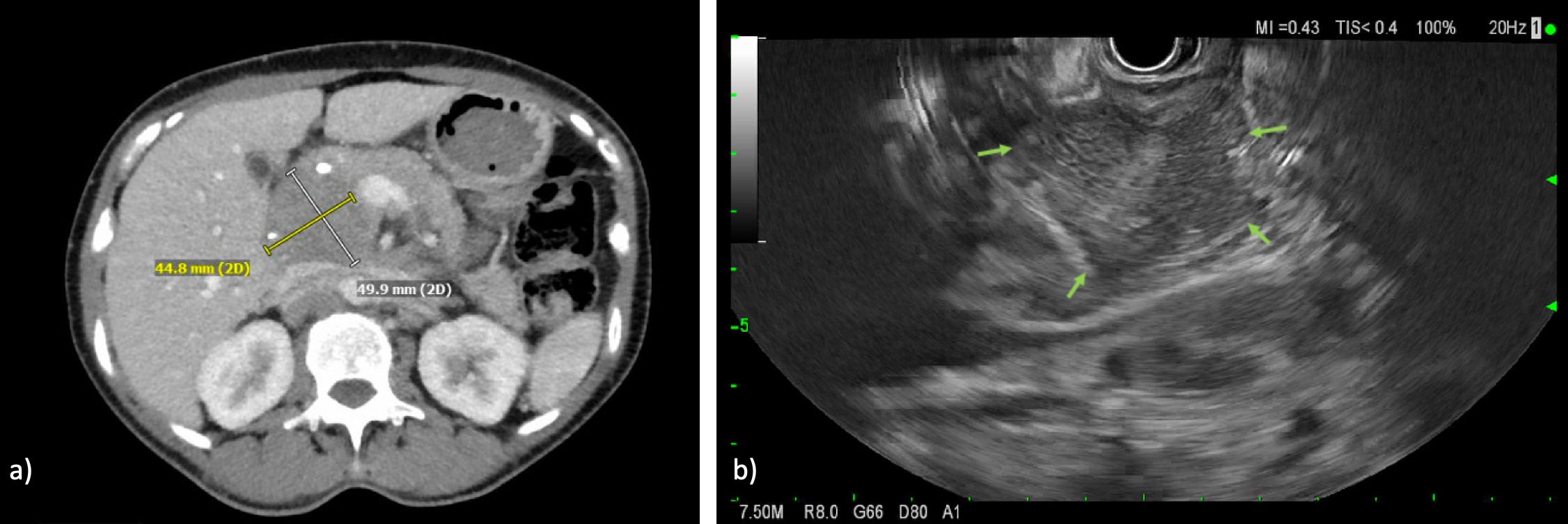Tuesday Poster Session
Category: Biliary/Pancreas
P2999 - Unmasking Obstructive Jaundice: A Rare Presentation of MALT Lymphoma
Tuesday, October 24, 2023
10:30 AM - 4:00 PM PT
Location: Exhibit Hall

Has Audio

Anastasia Chahine, MD
University of California Irvine
Orange, CA
Presenting Author(s)
Anastasia Chahine, MD, Amirali Tavangar, MD, Andy Lin, MD, Neil Jariwalla, MD, Jun Ho, , Samuel Ji, MD, Jason Samarasena, MD
University of California Irvine, Orange, CA
Introduction: MALT lymphoma, or extranodal marginal zone B-cell lymphoma, is a type of non-Hodgkin lymphoma that originates in the mucosa-associated lymphoid tissue (MALT) found in various parts of the body. While gastric MALT lymphoma is the most common form, occurring in about 50% of cases, it can also arise in other sites. Very rare cases have been reported in the liver. Here we describe an unusual presentation of MALT lymphoma as a hilar mass causing obstructive jaundice.
Case Description/Methods: A 62-year-old female presented with one week of jaundice. Laboratory tests revealed elevated Tbili at 6.3, ALP at 624, AST at 354, and ALT at 504. CT scan showed a dilated common bile duct and a 5 x 4.5 cm mass in the hepatic hilum abutting the pancreas and encasing the common hepatic artery and main portal vein (figure a). ERCP was performed, a bile duct stricture with upstream intrahepatic bile duct dilation was identified, and a stent was placed. Further evaluation with EUS/FNB revealed an atypical lymphoid proliferation suspicious for lymphoma but was not definitive. Tumor and autoimmune markers were within normal range, except for a slightly elevated CA19-9 level. Bone marrow biopsy was negative. The patient was subsequently referred to our hospital, where a repeat EUS identified a 5 x 4 cm mass near the hilum (figure b). FNB using a 22G needle resulted in the collection of a core specimen and the pathology report described sheets of small to medium B cells, along with scattered residual germinal centers. On immunohistochemical analysis the lymphoma cells expressed CD20, PAX-5, and CD23. There were no indications of large cell transformation or epithelial malignancy. Flow cytometry revealed a kappa-restricted B-cell population expressing CD19, CD20, CD22, CD23, and negative for CD5 and CD10. The diagnosis of MALT lymphoma was established, and a PET/CT scan demonstrated multiple lymphadenopathies on both sides of the diaphragm. Treatment was with R-bendamustine as surgical resection was not feasible due to the mass encasing the portal vein.
Discussion: The incidence of MALT lymphoma in the liver is exceedingly uncommon, making its identification challenging. The range of its clinical expression can be wide and varied, spanning from subtle symptoms to severe complications. This case exemplifies the utility of EUS and FNB in facilitating the diagnosis of challenging cases, particularly when a mass is localized in anatomically complex regions such as the liver hilum.

Disclosures:
Anastasia Chahine, MD, Amirali Tavangar, MD, Andy Lin, MD, Neil Jariwalla, MD, Jun Ho, , Samuel Ji, MD, Jason Samarasena, MD. P2999 - Unmasking Obstructive Jaundice: A Rare Presentation of MALT Lymphoma, ACG 2023 Annual Scientific Meeting Abstracts. Vancouver, BC, Canada: American College of Gastroenterology.
University of California Irvine, Orange, CA
Introduction: MALT lymphoma, or extranodal marginal zone B-cell lymphoma, is a type of non-Hodgkin lymphoma that originates in the mucosa-associated lymphoid tissue (MALT) found in various parts of the body. While gastric MALT lymphoma is the most common form, occurring in about 50% of cases, it can also arise in other sites. Very rare cases have been reported in the liver. Here we describe an unusual presentation of MALT lymphoma as a hilar mass causing obstructive jaundice.
Case Description/Methods: A 62-year-old female presented with one week of jaundice. Laboratory tests revealed elevated Tbili at 6.3, ALP at 624, AST at 354, and ALT at 504. CT scan showed a dilated common bile duct and a 5 x 4.5 cm mass in the hepatic hilum abutting the pancreas and encasing the common hepatic artery and main portal vein (figure a). ERCP was performed, a bile duct stricture with upstream intrahepatic bile duct dilation was identified, and a stent was placed. Further evaluation with EUS/FNB revealed an atypical lymphoid proliferation suspicious for lymphoma but was not definitive. Tumor and autoimmune markers were within normal range, except for a slightly elevated CA19-9 level. Bone marrow biopsy was negative. The patient was subsequently referred to our hospital, where a repeat EUS identified a 5 x 4 cm mass near the hilum (figure b). FNB using a 22G needle resulted in the collection of a core specimen and the pathology report described sheets of small to medium B cells, along with scattered residual germinal centers. On immunohistochemical analysis the lymphoma cells expressed CD20, PAX-5, and CD23. There were no indications of large cell transformation or epithelial malignancy. Flow cytometry revealed a kappa-restricted B-cell population expressing CD19, CD20, CD22, CD23, and negative for CD5 and CD10. The diagnosis of MALT lymphoma was established, and a PET/CT scan demonstrated multiple lymphadenopathies on both sides of the diaphragm. Treatment was with R-bendamustine as surgical resection was not feasible due to the mass encasing the portal vein.
Discussion: The incidence of MALT lymphoma in the liver is exceedingly uncommon, making its identification challenging. The range of its clinical expression can be wide and varied, spanning from subtle symptoms to severe complications. This case exemplifies the utility of EUS and FNB in facilitating the diagnosis of challenging cases, particularly when a mass is localized in anatomically complex regions such as the liver hilum.

Figure: a) CT abdomen and pelvis showing a 5 x 4.5 cm mass in the hepatic hilum abutting the pancreas and encasing the common hepatic artery and main portal vein. b) Endoscopic ultrasound (EUS) showing the mass near the liver hilum.
Disclosures:
Anastasia Chahine indicated no relevant financial relationships.
Amirali Tavangar indicated no relevant financial relationships.
Andy Lin indicated no relevant financial relationships.
Neil Jariwalla indicated no relevant financial relationships.
Jun Ho indicated no relevant financial relationships.
Samuel Ji indicated no relevant financial relationships.
Jason Samarasena: Applied Medical – Advisor or Review Panel Member. Boston Scientific – Consultant. Conmed – Consultant. Cook – Educational Grant. Neptune Medical – Consultant. Olympus – Consultant. Steris – Consultant.
Anastasia Chahine, MD, Amirali Tavangar, MD, Andy Lin, MD, Neil Jariwalla, MD, Jun Ho, , Samuel Ji, MD, Jason Samarasena, MD. P2999 - Unmasking Obstructive Jaundice: A Rare Presentation of MALT Lymphoma, ACG 2023 Annual Scientific Meeting Abstracts. Vancouver, BC, Canada: American College of Gastroenterology.
